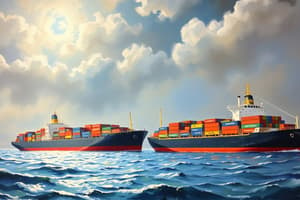Podcast
Questions and Answers
What defines 'heavy weather' at sea?
What defines 'heavy weather' at sea?
- Calm seas with good visibility
- Strong winds and high waves (correct)
- Heavy fog with light rains
- Cloudy skies and mild temperatures
What is an essential precaution for personnel on deck during severe weather conditions?
What is an essential precaution for personnel on deck during severe weather conditions?
- Avoid working in groups
- Wear regular clothing
- Use appropriate winter gear (correct)
- Stay on the upper deck at all times
What should be secured to prevent movement during heavy weather?
What should be secured to prevent movement during heavy weather?
- Loose material in stores and deck (correct)
- Vessel hull details
- Watertight doors
- Cargo transfers
How should ballast/bilge sounding pipes be maintained during heavy weather?
How should ballast/bilge sounding pipes be maintained during heavy weather?
What is an important action to take regarding machinery before operation in cold weather?
What is an important action to take regarding machinery before operation in cold weather?
What should be monitored during heavy pitching to prevent loss of suction in pumps?
What should be monitored during heavy pitching to prevent loss of suction in pumps?
What should be modified in advance to avoid parametric rolling in container vessels?
What should be modified in advance to avoid parametric rolling in container vessels?
What procedure should be followed to ensure the vessel's fuel reserves during extreme weather?
What procedure should be followed to ensure the vessel's fuel reserves during extreme weather?
What is one of the key issues with the design of single-side skin bulk carriers?
What is one of the key issues with the design of single-side skin bulk carriers?
During which step of the digging process can damage occur to the frames and hopper side?
During which step of the digging process can damage occur to the frames and hopper side?
To avoid damaging the inner bottom plating (tank top) during cargo handling, what is the recommended action?
To avoid damaging the inner bottom plating (tank top) during cargo handling, what is the recommended action?
What should be done to ensure hatch covers do not cause unsafe conditions during cargo operations?
What should be done to ensure hatch covers do not cause unsafe conditions during cargo operations?
What primary role does the person in charge play during lightering operations?
What primary role does the person in charge play during lightering operations?
When operating a grab, why is it essential to land the grab straight and parallel to the ship's side?
When operating a grab, why is it essential to land the grab straight and parallel to the ship's side?
What is the consequence of swinging the grab at an angle during cargo handling?
What is the consequence of swinging the grab at an angle during cargo handling?
Which of the following actions is NOT recommended to prevent damage during cargo transfer?
Which of the following actions is NOT recommended to prevent damage during cargo transfer?
Study Notes
Bulk Carrier Damage Prevention
- Common grab damage during unloading includes damage to ladders, coamings, frames, hopper sides, and tank tops.
- Prevent damage to tank tops by lowering the grab slowly and evenly, maintaining a grip when moving, and exercising caution when there are items on the tank top.
- Prevent damage to hatch coamings and covers by ensuring they are fully open and clear of obstructions.
- Payloaders should operate carefully near ladders and avoid grinding corners of the bucket to prevent damage.
Safe Lightering Operations
- Seven important points for safe lightering operations include a designated person in charge, master's knowledge and responsibility, communication, mooring and unmooring, cargo and cargo transfer equipment use, weather, and operational checklists.
Severe Weather Conditions
- Heavy weather refers to challenging sea conditions including strong winds, high waves, rough seas, and poor visibility.
- Personnel should wear appropriate winter gear, exercise caution on ice decks, and work in groups of two or more on the lee side during heavy weather.
- Machinery should be warmed up in advance and cooling water should be checked for antifreeze in cold weather.
- Check to ensure anchors are properly contained and secured with additional lashings.
- Tighten gangway lashings regularly to prevent movement and damage.
- Ensure cargo is secured with proper lashings, shoring, or tomming as needed.
- Maintain a safe distance from the lee side during heavy weather.
- Check for open caps on ballast, bilge sounding, and temperature pipes to prevent water ingress.
- Consult with the Chief Engineer to reduce engine RPMs to acceptable levels and prevent slamming.
- On container and PCC vessels, modify route and speed in advance to avoid heavy rolling.
- Maintain lube oil sump levels for both the main and auxiliary engines to prevent pumps losing suction.
- Ensure seawater pumps are set to low suction to avoid losing suction during heavy pitching.
Studying That Suits You
Use AI to generate personalized quizzes and flashcards to suit your learning preferences.
Related Documents
Description
This quiz covers essential practices for preventing damage during bulk carrier operations, including unloading and lightering. Key safety tips for navigating severe weather conditions are also highlighted. Test your knowledge on maintaining vessel integrity and ensuring safety protocols are followed.




